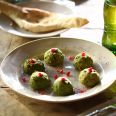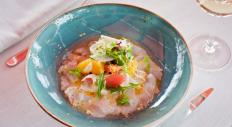Old New Year
On the eve of Vasilev Day which earlier fell on the 1st of January, Russia marked Vasilev Night. It was a tradition to cook celebratory dishes

On the eve of Vasilev Day which earlier fell on the 1st of January, Russia marked Vasilev Night. It was a tradition to cook celebratory dishes, receive guests and tell fortunes on that festive evening. Svyatki (Christmastide) fortunetelling made on the night of January 13th was considered to always come true. Girls tried to see their future husbands with the help of a mirror.
After the Gregorian calendar was introduced, Svyatki in Russia and the CIS countries are from January 7th till January 19th, and the New year "has dropped out" of Svyatki holidays. But Svyatki are not Svyatki without the New Year. Therefore the Old New Year is certainly seen in on January 13th.
Twelve days coming after Christmas are called Svyatki, which means "sacred days", as these twelve days are consecrated by great events of Christmas. In the first three centuries of Christianity when persecutions hindered the freedom of Christian worship, some eastern churches incorporated the holiday of Nativity into the holiday of Baptism under the general name of Epiphany.
The Church started to consecrate twelve days after the Nativity in the ancient times. The Church Charter of Reverend Savvy Consecrated (died in 530) which included even more ancient regulations, writes that in Svyatki days "there is neither fasting, nor genuflection, neither in church, neither in cells", and religious rite of marriage is prohibited. The Second Turon Council in 567 announced all the days from the Nativity to the Epiphany celebratory. However, people thought that on Svyatki nights evil spirit specially appeared to intimidate the Orthodox believers. Deadmen, ghosts, wood-goblins, malicious spirits scurried around dark streets trapping their victims. Fortunately, no one slept those nights. Girls eager to know their fate were telling fortune all night long without a break. They poured kindled wax into water; and threw a shoe behind the gate to see where it points – the husband was supposed to come from that direction. Sometimes they would take a candle and a mirror and go into an empty bath-house where they could see a promised husband – though it was the most dangerous place, where the girl could be attacked by shaggy "svyatki-people". Young men were also quite busy: they had to dress up as wood-goblins, or even hide in the bath-house, where the girls came to tell fortune.
The main celebratory dish on Vasilev Day was a roasted whole pig, hare, and rooster. Our ancestors believed that a roasted pig provided well-being for the future year, the hare was eaten to be as quick as a hare, and the rooster - to be as light as a bird. Nowadays at night of January 13th many people see the Old New Year in, reviving a tradition to treat your guests to lavish meal. Pork or chicken dishes will be the most appropriate on this day on the celebratory table.
The tradition to see the Old New Year in appeared after 1918 when new chronology was introduced in Russia.
Ukrainian Borscht With Duck
300g beef brisket
350g duck
200g sausages
50g dried mushrooms
200g cabbage
500g beet
1-2 onions
100g parsley, celery
100g margarine
200g sour cream
spices to taste
Boil beef brisket in meat broth (about 3/4 doneness). Julienne vegetables. Simmer beet, roots and onions in skimmed fat. Filter the broth and add cabbage, simmered vegetables, slightly fried duck, beef brisket, dried mushrooms (pre-soaked and sliced), spices, "bouquet" with addition of cloves and cook until ready. Take the prepared meat products out of the borscht, throw away the "bouquet".
Dress the borscht with sour cream, beet broth, sugar and salt to taste. At serving, put slices of brisket, duck, slightly fried sausage and fresh herbs.
Nizhny Novgorod Pilaf
300g lamb
400g rice
3 carrots
1 greater onion
100g fat
ground red pepper
1 tsp dried barberry – desirable
2 bulbs garlic
Pilaf is cooked in a special pan called kazan or in a thick-walled saucepan, a cast-iron cauldron, a stew-pan. Pour 2-2.5cm of fat on the bottom of the pan. It can also be vegetable oil (olive, sesame, sunflower) half-and-half with butter or animal fat pre-heated at low heat. First put small slices of meat, then onion rings and sliced carrots. The products should not stick to the bottom or burn. When the meat is covered with a ruddy crust, add spices and rinsed rice (better long-grained). Level the rice carefully without stirring. Rinse garlic bulbs and stick them in the rice so that the stems are above the rice. Add water so that it is about 1-1.5cm above the rice level. Cover tightly with a lid and cook 40 minutes at very low heat. The pilaf is ready when holes appear on the surface and the rice absorbs all the water. Serve the pilaf on a big dish, taking it from the saucepan layer by layer: rice, then vegetables and meat. Throw away the garlic.
Suzdal Duck
duck
3-4 apples
10-15 prunes cored
mayonnaise, salt, black ground pepper
Peel and core apples, slice into not very fine segments. Rinse and halve prunes (you can leave large berries), combine with apple segments. Rinse and dry duck, rub the outside and the inside with salt and pepper, then with mayonnaise, stuff with prunes and apples, fix together the belly with wooden skewers (or sew up with a thread) and put in a stew-pan for duck. Put in the oven preheated to 200 C (or higher), without covering and keep until the duck gets brown. Then add water so that the duck"s back touches the water, cover with a lid and reduce heat up to 130-150 C. Stew 1.5-2 hours, periodically watering with the appearing sauce.
Celebratory Duck
1.5-2 kg medium-sized duck
100g butter
200g white wine
1 lemon
50g sour cream
salt, pepper
parsley to taste
Rinse and clear the duck, salt, pepper, sprinkle with lemon juice and fry in butter, then pour it over with wine and put in the oven for 35-45 minutes until a light-brown crust appears. Pour it over every 10 minutes with the sauce appearing on the baking tray to prevent from drying or burning. Put the prepared duck on a dish, pour it over with the sauce combined with sour cream, top with lemon segments and fresh parsley.
Pie "Boyar Hat"
2.5 cups flour
200g margarine or butter
3 eggs
1 cup sugar
4-5 sour apples
Chop margarine with flour. Pound yolks with about 1/3 cups of sugar (or mix in a blender). Roll the dough in a ball, take a piece the size of a walnut and put it in a cold place (for further decoration). Butter the form and sprinkle it with breadcrumbs. Put the dough shaping it as a "basket". Peel, core and grate sour apples. Whisk egg whites with about 2/3 cup of sugar. Grate the piece of dough. Put the apple julienne on the bottom of the "basket", cover with whisked egg whites and sprinkle with grated dough. Bend up the edges and bake in a hot oven.
Makoviki
1 1/2 cups flour
3 tbsp sour cream
2 tbsp butter
3 eggs
1 1/2 cups poppy seeds
1/4 tsp soda
1 cup sugar
Pound yolks with sugar, add sour cream and butter, and whisk together until homogeneous. Combine flour with soda and add to the mass. Leave well-kneaded dough for 30-40 minutes in a cool place then roll it out into a square 1cm thick and cut into strips 5-6cm wide with the length of your baking tray. Roll the off-cuts of dough into a thin rope and put it on tips of the strips brushed with egg to form the side. Put poppy seeds (pounded with sugar and 3 egg whites whisked into foam) on the strips and level it. Bake at 220-230 C. Chill the prepared makoviki and cut into squares.
Christmas Tvorozhnik
500g flour
40g yeast
150g milk
130g margarine
salt
150g sugar
2 eggs
rum
150g cottage cheese
vanilla
butter
powdered sugar
Knead dough from part of the flour (approximately 2/3 of the norm), margarine, yeast dissolved in warm milk, sugar, salt, eggs, and leave for some time in a warm place. Press cottage cheese through a sieve, add a little rum, vanillin. Add it all to the dough and combine with the remaining flour. Shape it as a bun, make a groove 1cm deep and bake 45 minutes at average temperature. Butter the hot pie and sprinkle with powdered sugar. If the pie has burned, you can try to rescue it, scrubbing the burned places with a fine metal grater.
Cake With Guelder-Rose Berries
for dough:
550g flour
225g water
20g salt
0.6g lemon acid
200g butter
for cr
Pkhali from the Chef of Kharcho Restaurant
Pkhali is one of the most popular and beloved by many people dishes of the Georgian cuisine. It is very easy to cook and there are so many variations. You may use almost any vegetables and herbs to co...
Marinated cod
There are lots of recipes to cook marinated fish. A great variety of such recipes consists of frying pieces of fish in oil. I would like to offer you a recipe of lean fish in marinade. It gets tasty, ...
Fresh sea bass carpaccio with citrus sauce
Hospitable and vivacious brand-chef of Park Giuseppe Restaurant Sergey Lasarev showed us how to cook fresh sea bass carpaccio with citrus sauce – a simple but dainty food.







